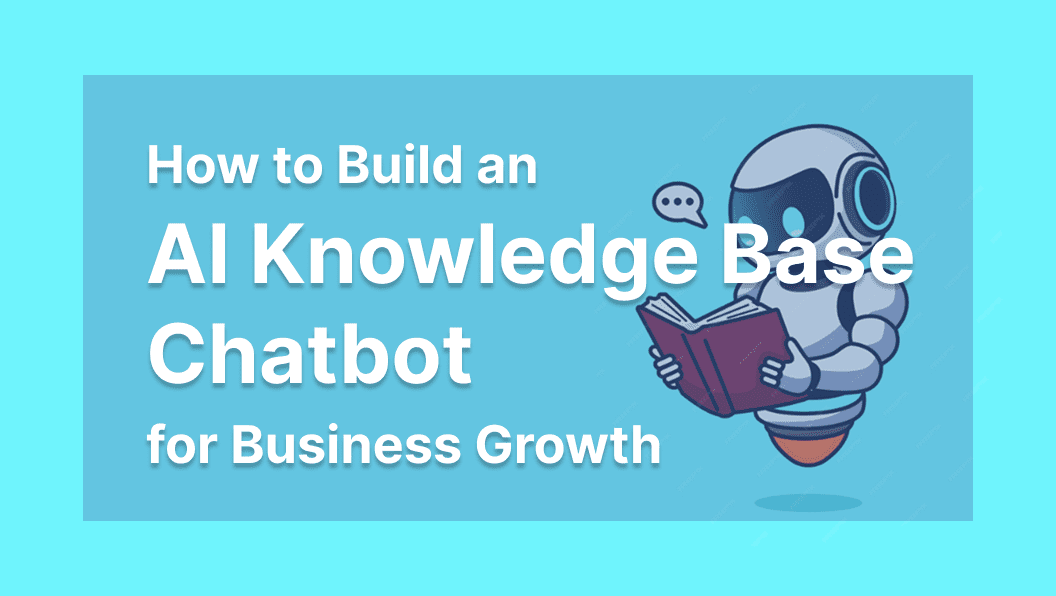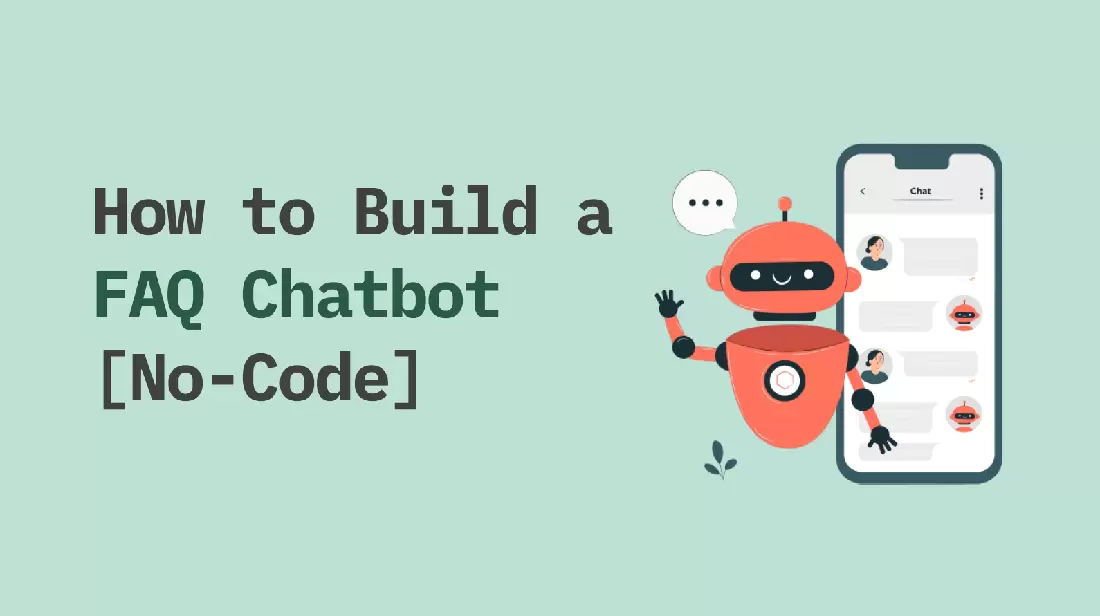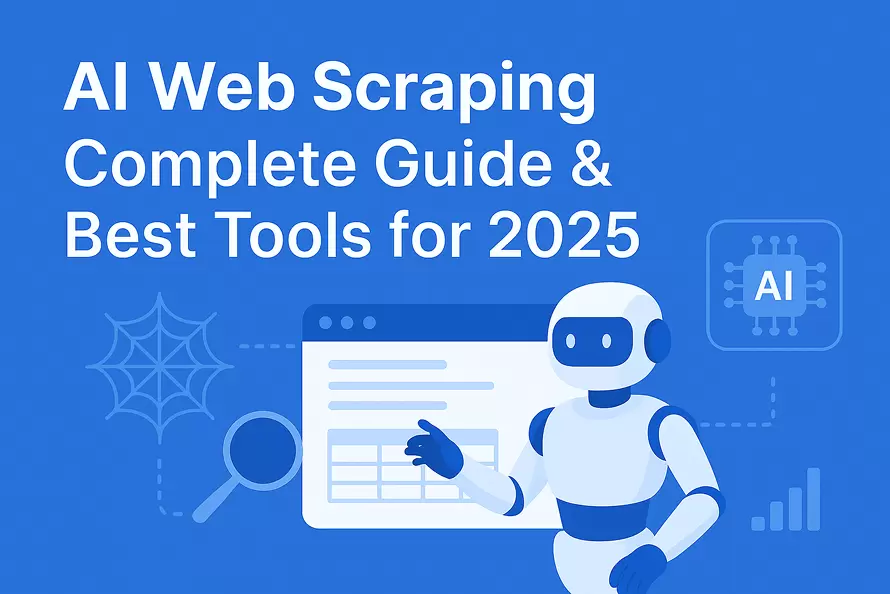
You’re a small business owner with a great idea for a new customer service app. You don’t know how to code, and hiring a full development team feels far too expensive and time-consuming.
In the past, this would have meant shelving the idea or relying on limited off-the-shelf tools. But in 2025, the landscape is completely different. With the rise of AI tools for non-technical users (B2B), you can now design apps, build automation workflows, analyze data, or even launch AI-powered chatbots; all without ever writing a single line of code.
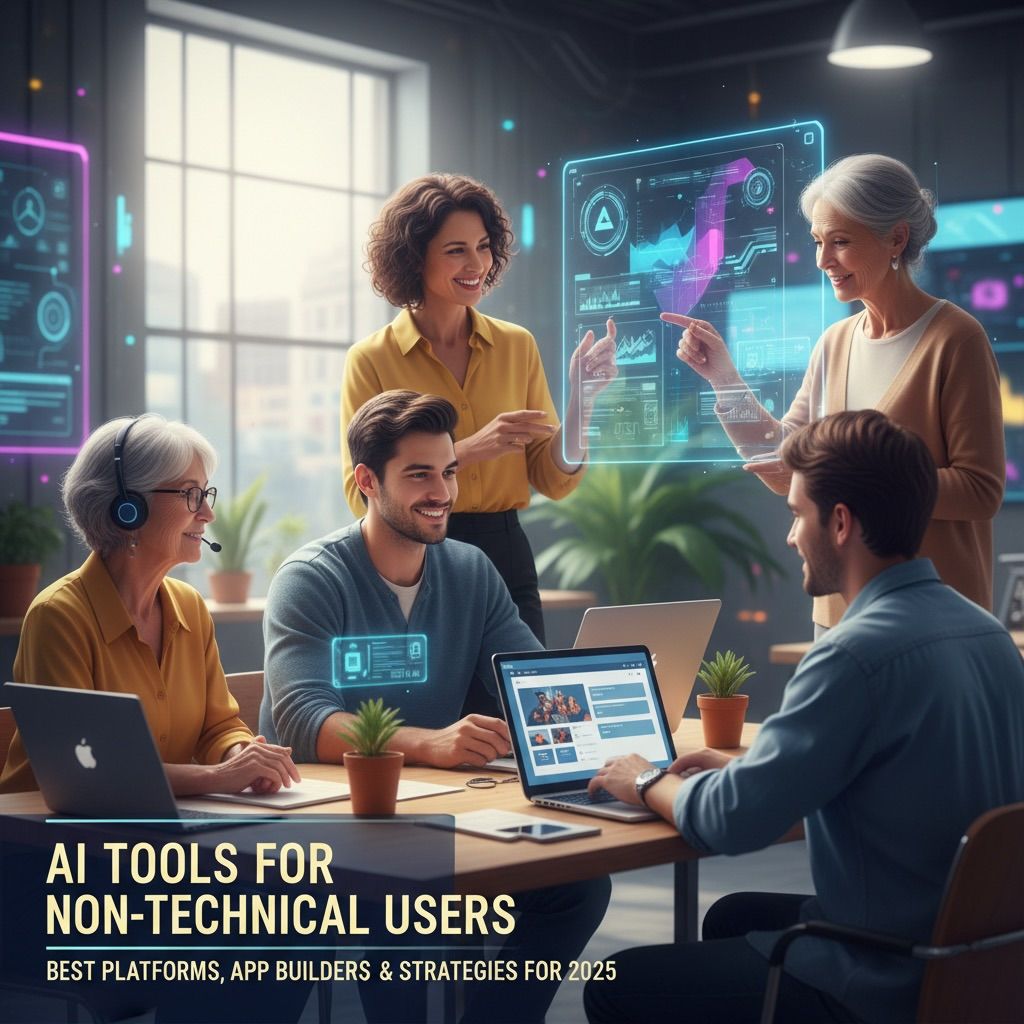
This shift isn’t just happening for individuals. Startups, mid-sized companies, and even large enterprises are finding that AI tools for non-technical entrepreneurs allow teams across sales, marketing, HR, and operations to innovate faster and work smarter. By lowering the technical barrier, AI is democratizing access to advanced capabilities that were once reserved only for trained developers or data scientists.
In this detailed post, we’ll explore the best AI platforms and strategies for 2025 that are specifically designed for non-technical users.
What Counts as “AI Tools for Non-Technical Users”?
AI tools for non-technical users are software that let people with little or no coding skills apply AI to real problems. Instead of building models or writing code, users interact through simple interfaces like drag-and-drop builders, natural-language prompts, templates, or visual flows. These tools hide technical details but deliver practical outcomes.
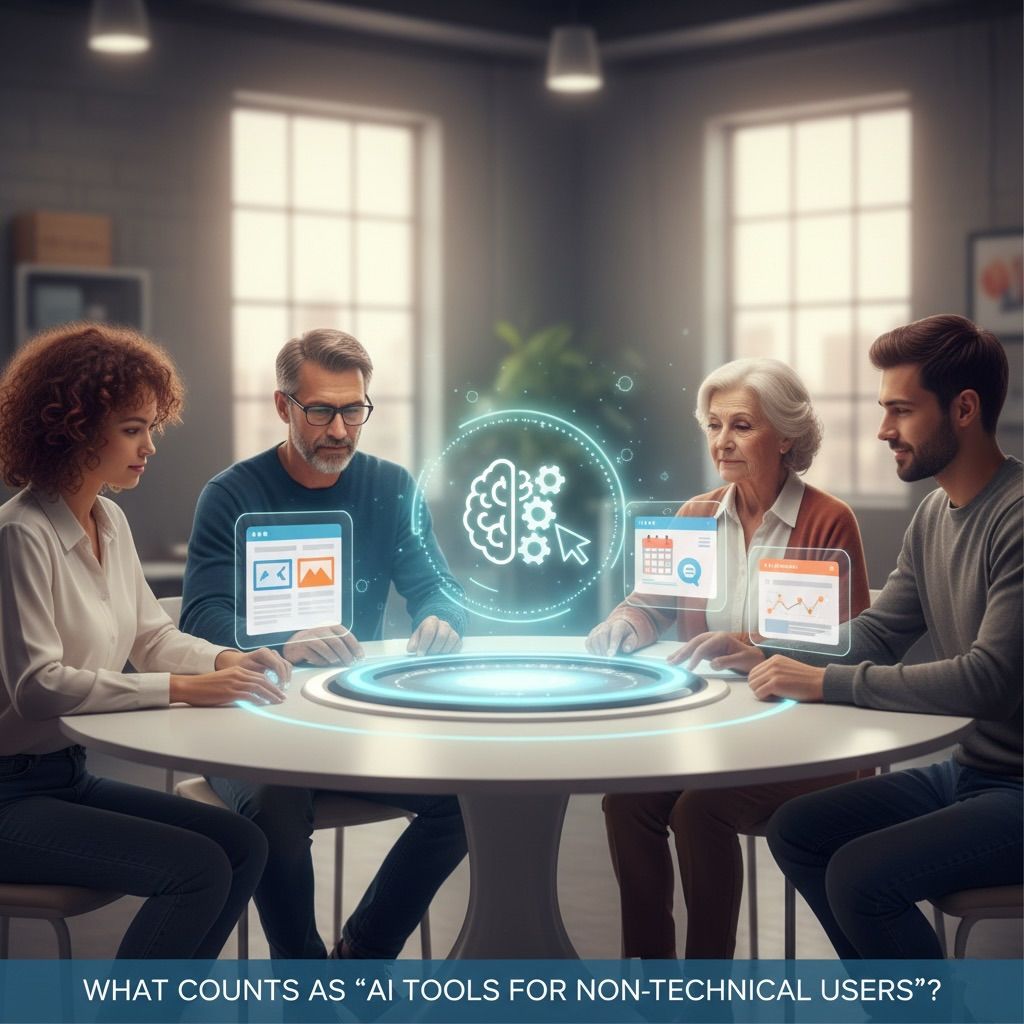
In short, they help turn business questions into answers, actions, or automated workflows that teams in marketing, HR, sales, or support can run on their own.
In short, they help turn business questions into answers, actions, or automated workflows that teams in marketing, HR, sales, or support can run on their own.
Core Categories
- No-code / Low-code AI Builders – Visual platforms where apps or workflows are assembled from pre-built blocks, often with AI modules for tasks like summarization or classification.
- Chatbots & Conversational AI – Simple editors to set up assistants that answer FAQs or route customer queries.
- AutoML Tools – Upload data, set a goal, and let the system handle model training for tasks like forecasting or classification.
- AI Analytics & BI – Translate plain questions into charts, dashboards, or insights without needing SQL.
- RPA + AI – Automations enhanced with OCR or document understanding for invoices, onboarding, or forms.
- Semantic Search – Search tools that understand meaning, not just keywords, to find relevant answers in documents.
- Content Creation Tools – Generate marketing copy, images, or social posts through guided prompts.
- Voice & Multimodal Interfaces – Accept speech or images as inputs, useful where typing isn’t practical.
Common Traits
- Natural-language or visual interfaces (no coding).
- Pre-built templates and guided wizards.
- Human-in-the-loop review options.
- Explainable outputs (citations, confidence notes).
- Built-in security and governance basics.
Why Organizations Use Them
These tools speed up results by letting non-technical teams handle simple tasks without waiting for developers. Benefits include:
- Faster prototyping and time-to-value.
- Reduced reliance on scarce technical talent.
- Closer alignment of business needs and outcomes.
- Ability to test ideas quickly at low cost.
Guidance for Leaders
Start small with pilots that solve clear, repeatable problems. Assign a business owner, keep oversight light but consistent, and review sample outputs. Train a few “power users” to share best practices across teams. Focus on small wins and gradual scaling rather than big projects.
How to Evaluate AI Platforms for Non-Technical Teams
Choosing the right AI tools for non-technical users is not just about finding software with flashy features. For teams without coding or deep technical expertise, the real question is: Can this platform deliver business value while staying easy to use, secure, and scalable? Evaluating platforms carefully helps avoid wasted investments and ensures that AI supports real outcomes rather than creating complexity. Below is a structured framework to guide businesses, startups, and leaders when assessing AI platforms.

1. Ease of Use and Accessibility
The first consideration is whether non-technical staff can realistically operate the platform. A good tool should feel approachable, with interfaces that don’t demand coding or advanced configurations.
- Visual and guided workflows: Drag-and-drop builders, templates, and wizards simplify setup.
- Natural language interaction: Platforms that let users ask questions or issue commands in plain English reduce training needs.
- Onboarding and tutorials: Built-in guidance ensures teams can adopt the tool quickly without constant IT support.
For AI tools for non-technical entrepreneurs, ease of use is even more important since small business owners often juggle multiple roles and cannot dedicate hours to learning complex systems.
2. Integration with Existing Systems
No AI tool exists in isolation. To be effective, it must fit seamlessly into the organization’s ecosystem.
- Native connectors: Check if the platform integrates with common tools like Google Workspace, Slack, Salesforce, Shopify, or industry-specific software.
- APIs and webhooks: Even non-technical teams may need flexible integration options as the business grows.
- Data import/export options: The ability to bring in spreadsheets, documents, or CRM data without technical hurdles is crucial.
A platform that works smoothly with existing workflows reduces resistance from employees and accelerates adoption.
3. Reliability, Accuracy, and Performance
Since non-technical teams often lack the expertise to troubleshoot errors, the AI platform itself must be reliable and trustworthy.
- Accuracy of outputs: Look for platforms that use semantic understanding, contextual relevance, and explainable AI.
- Speed and uptime: Response times should be quick, and downtime must be minimal, especially for customer-facing tools.
- Transparency: Tools that provide citations, confidence scores, or explain “why” a result was generated build trust among non-technical users.
4. Security and Compliance
Data privacy is one of the most critical considerations. Even small teams must think about compliance, especially if customer data is involved.
- Role-based access: Ensure different team members can have appropriate permission levels.
- Encryption and SOC2/GDPR compliance: Platforms should meet industry-standard security certifications.
- Audit trails: Non-technical leaders benefit from systems that automatically log activity for accountability.
This is particularly important for AI tools for non-technical entrepreneurs in regulated industries like healthcare, finance, or legal services.
5. Scalability and Flexibility
A platform that works for a 5-person team should also scale as the organization grows. Evaluate whether the AI tool can handle larger workloads, more integrations, or more complex queries over time.
- Tiered pricing models: Look for flexible options that allow upgrading as needs expand.
- Customization options: While non-technical users need simplicity, the platform should still allow growth into more advanced features if needed.
- Future-ready AI capabilities: Platforms that support multimodal AI (text, voice, image) are more likely to remain relevant in coming years.
6. Cost and ROI
Budget is always a factor, especially for startups and small businesses. But cost should be weighed against value delivered.
- Transparent pricing: Clear pricing tiers without hidden costs help non-technical leaders plan better.
- Trial options: Free trials or demos let teams test usability before committing.
- ROI measurement: Consider whether the tool has built-in analytics to show time saved, tasks automated, or revenue impact.
7. Vendor Support and Community
Non-technical teams often rely on external support when problems arise. Strong vendor support can make the difference between a successful rollout and a failed experiment.
- Customer support availability: Live chat, email, or even dedicated account managers.
- Learning resources: Documentation, video tutorials, and webinars should be available in simple language.
- User community: Platforms with active communities (forums, LinkedIn groups, Slack channels) provide peer-to-peer support and practical advice.
8. Governance and Control
Even with user-friendly AI tools, businesses need some guardrails. Tools should provide basic governance features to ensure consistent, responsible usage.
- Usage monitoring: Dashboards that show who is using what features.
- Version control: Helpful for tracking changes in workflows or templates.
Human oversight: Allowing easy review and correction of AI outputs before deployment.
Best Platforms for Non-Technical Users to Build AI Agents
1. GPTBots

Most AI platforms are built for programmers, which makes it hard for non-technical users to create and manage AI agents. GPTBots solves this challenge by offering a no-code platform that lets anyone build, deploy, and run AI agents with ease.
Unlike traditional tools with steep learning curves, GPTBots is designed for accessibility. Entrepreneurs, small businesses, and even large enterprises can create industry-specific AI agents in just hours using its visual interface, expert guidance, and ready-to-use templates.
What sets GPTBots apart is its focus on practical business needs. Whether for customer support, sales, HR, or healthcare, it provides customizable agents that deliver real value.
Here’s why GPTBots has become one of the most recommended AI tools for non-technical users and why it holds the top position in our list:
- No-Code AI Agent Creation
- Knowledge Base & Real-Time Sync
- Preset Templates & Guided Setup
- Multi-LLM Collaboration
- Private Deployment & Security
- Cross-Platform Lead Capture & Integrations
Users can build and launch AI agents through a simple visual interface; no coding skills required. This makes it equally effective for solo entrepreneurs and enterprise teams.
AI agents connect directly with enterprise databases, APIs, and documents. Updates sync in real-time so agents always provide accurate and fresh responses.
GPTBots offers pre-built AI Agent templates for customer service, sales, HR, and more. Plus, expert assistance is available to guide non-technical users through every step.
The platform combines multiple large language models (LLMs), including DeepSeek, to enhance capabilities such as voice, image, sentiment analysis, and code interpretation.
For businesses with sensitive data, GPTBots offers private deployment options along with SOC2 compliance, ensuring that AI agents meet enterprise-grade security standards.
From WhatsApp and Discord to CRMs and APIs, GPTBots seamlessly integrates across tools to automate workflows and unify data streams.
Pros
-
Intuitive no-code interface; perfect for non-technical teams.
-
Automates up to 90% of customer inquiries, cutting support costs significantly.
-
Supports 90+ languages for global and multilingual service.
-
Integrates directly with CRMs, databases, and APIs for seamless operations.
-
Industry-focused templates save setup time.
-
Flexible deployment options, including private enterprise AI setups.
-
Recognized as a top AI app builder for non-technical teams 2025.
Cons
-
Advanced customization features may require higher investment.
-
Aside from cost, there are no real disadvantages, which is why GPTBots ranks #1 in our list.
2. Relevance AI
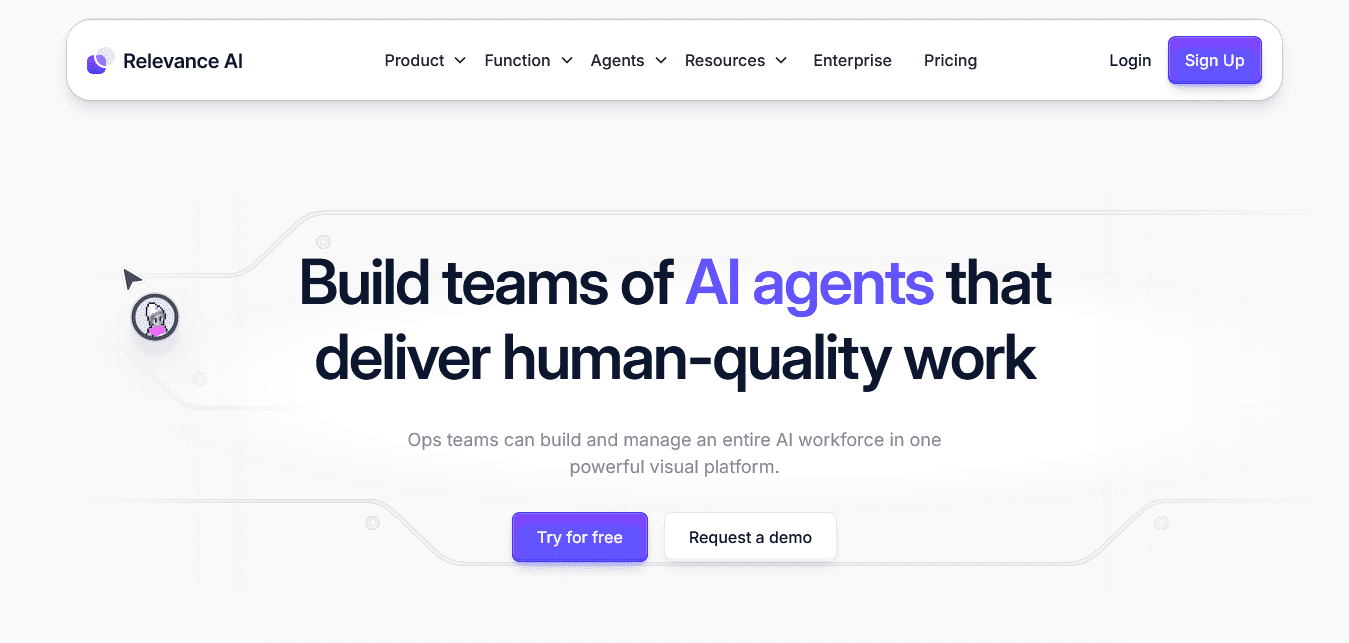
For organizations that want to go beyond single-purpose automation, Relevance AI provides a platform to build an AI Workforce; a coordinated system of digital agents that can handle multiple tasks simultaneously. Unlike traditional tools that only focus on chatbots or workflow automation, Relevance AI is designed to empower teams to create, manage, and deploy agents that collaborate across different departments. This makes it one of the best platforms for non-technical users AI agents, especially for businesses that deal with repetitive tasks and need scalable automation.
The platform is fully no-code, allowing non-technical teams to build AI-driven workflows through an intuitive interface. At the same time, advanced users can extend functionality with custom code, ensuring flexibility. Relevance AI supports multi-provider LLMs like OpenAI, Anthropic, and Cohere, giving businesses the freedom to select the best AI backbone for their use cases. Security is also a strong focus, with SOC 2 Type II compliance and a privacy-first design that avoids storing user inputs and outputs.
Pros
-
Easy for non-technical teams to build and scale AI agents.
-
Strong multi-agent system that supports enterprise-level collaboration.
-
Fast customer support and reliability.
-
Handles unstructured data effectively for analytics and insights.
-
Flexible with the option to extend automation using Python code.
Cons
-
Pricing model based on credits can be expensive for scaling.
-
Lacks some built-in integrations (e.g., BigQuery).
-
Best suited for AI workflows; customization for non-AI use cases is limited.
3. Voiceflow
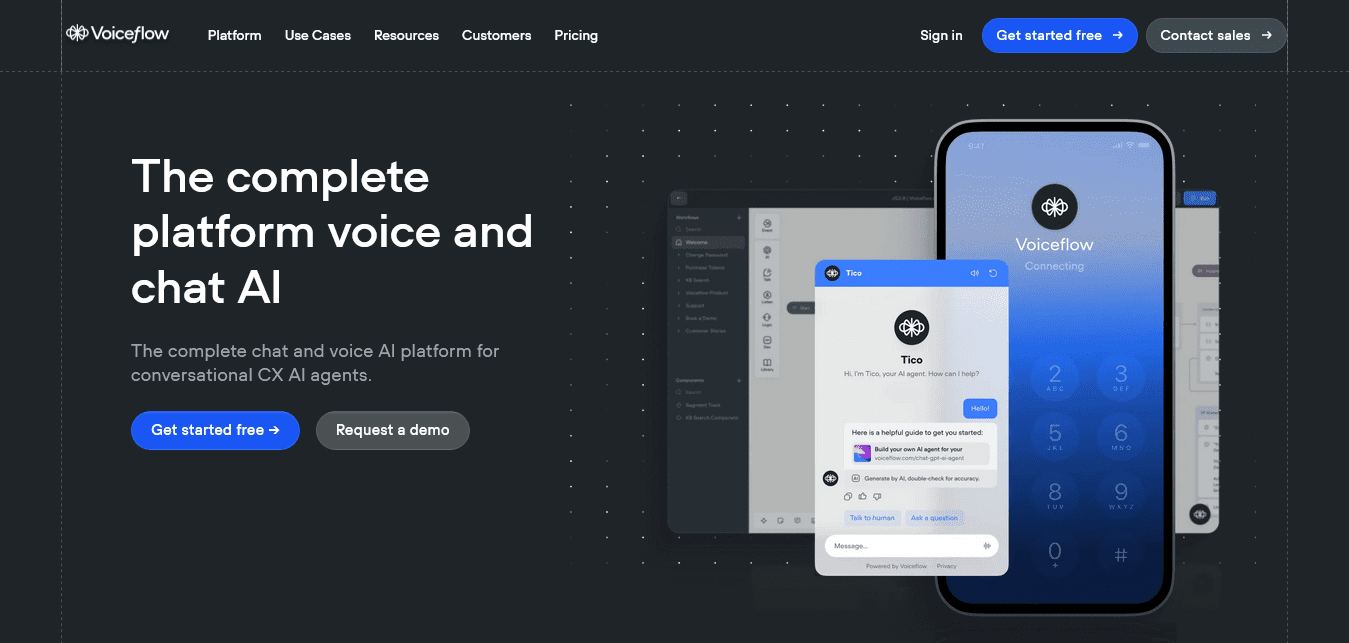
Voiceflow is one of the most popular top AI app builder for non-technical teams 2025 when it comes to conversational AI. Originally focused on building voice assistants, the platform has evolved into a multi-channel conversational AI tool that supports chatbots, messaging apps, and even multi-modal experiences. What sets Voiceflow apart is its drag-and-drop conversation builder, which makes it simple for designers, product managers, and non-technical teams to map out complex conversational flows without needing programming knowledge.
Voiceflow emphasizes collaboration. Teams can co-design, test, and iterate conversational experiences in shared workspaces, making it particularly valuable for fast-moving organizations. The ability to integrate large language models (LLMs) like GPT further strengthens its potential to build dynamic, intelligent, and natural conversation flows. While its strength lies in prototyping and deploying chat-based agents quickly, it does have limitations in advanced analytics and testing capabilities.
Pros
-
Intuitive no-code interface; perfect for non-technical teams.
-
Intuitive and beginner-friendly interface.
-
Strong team collaboration features for non-technical users.
-
Multi-channel support ensures reach across platforms.
-
Flexible integrations extend functionality beyond basic chatbots.
Cons
-
Analytics and reporting are limited.
-
Manual version testing can be clunky.
-
Some instability due to updates or deprecated features.
-
More suited for conversation-first use cases than complex workflows.
4. n8n
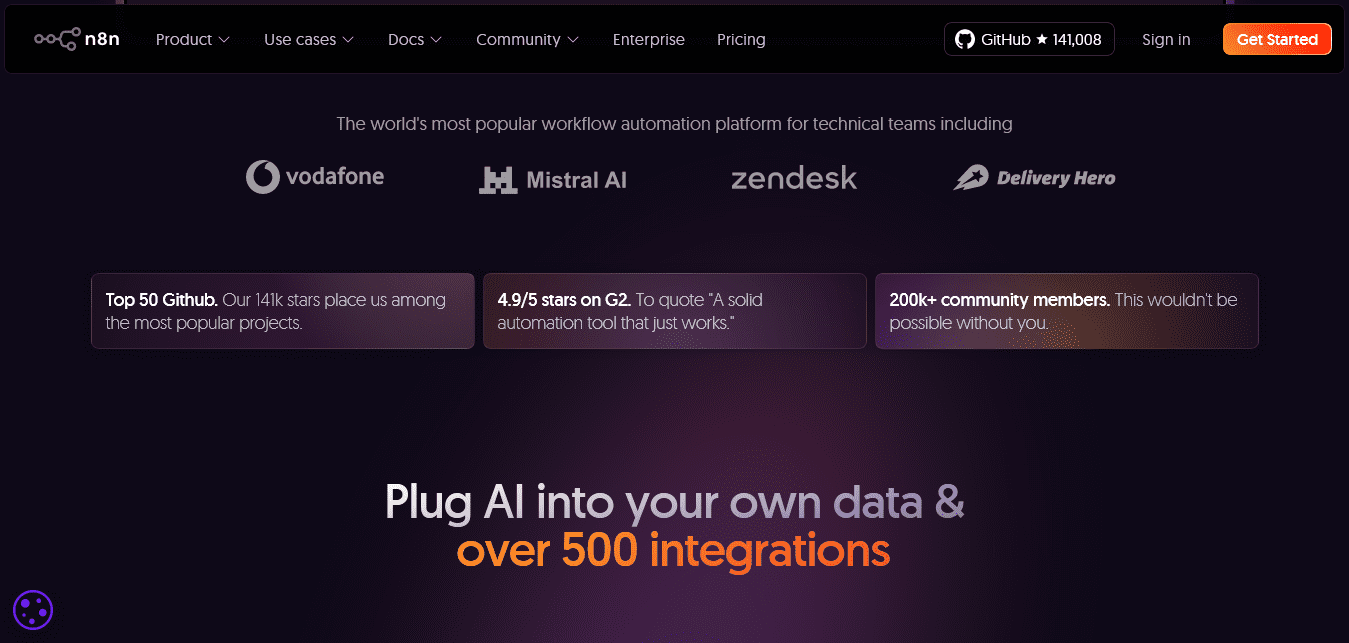
For businesses that need flexibility beyond simple automation, n8n is another helpful option. It combines the simplicity of no-code workflow builders with the flexibility of low-code customization, making it an excellent middle ground between tools designed purely for beginners and platforms built for developers. This balance is why it is recognized as one of the best platforms for non-technical users AI agents, especially for organizations that want control over their automation without starting from scratch.
n8n uses a visual, node-based workflow builder that lets users drag and connect functions to create automations. Non-technical users can rely on its library of integrations, while more advanced users can extend workflows with JavaScript or APIs. The platform also offers self-hosting options, which makes it appealing to businesses that require data privacy and ownership. Its ability to integrate with multiple sources, run advanced AI workflows, and debug processes visually makes it a powerful tool for both small startups and enterprise teams.
Pros
-
Combines ease of no-code with flexibility of low-code.
-
Supports advanced workflows with custom code.
-
Built-in AI agent enhances productivity with contextual assistance.
-
Wide range of app connectors for streamlined automation.
-
Self-hosting gives businesses control over data and compliance.
Cons
-
Steeper learning curve compared to purely no-code tools.
-
Limited documentation for advanced AI features.
-
Can be complex for users with no technical background at all.
5. Crew AI
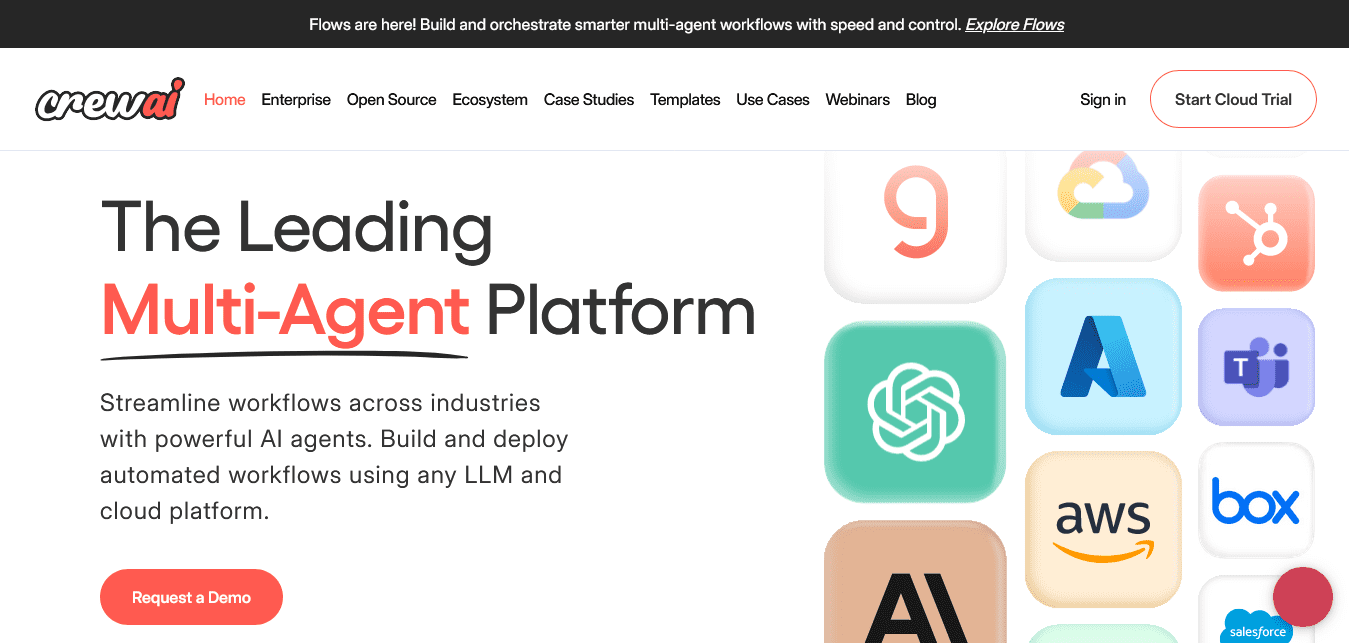
When it comes to building AI strategies for non-technical leaders, one of the challenges is coordinating multiple agents that can work together rather than just running single-task automations. Crew AI addresses this gap with its CrewAI Studio, a no-code platform that allows users to design and deploy multi-agent systems in a simple, visual way. The idea is to create specialized agents and then organize them into collaborative “Crews” that handle complex workflows collectively.
Even though the underlying framework is Python-based, the drag-and-drop node editor makes it accessible for non-developers. This means a business leader with no technical background can still design an entire AI workflow, test it, track agent performance, and make improvements; all without writing code. Crew AI also gives users the flexibility to choose their environment, whether that’s running locally, deploying on the cloud, or using Docker setups. For teams with unique requirements, it also supports custom tools, like APIs, advanced scraping methods, and file handling, making it versatile for both simple and advanced projects
Pros
-
Simplifies multi-agent system creation for non-technical teams.
-
Provides full visibility into agent workflows and performance.
-
Highly flexible deployment options (local, cloud, Docker).
-
Supports custom tools and integrations for advanced use cases.
-
Strong balance of accessibility for beginners and depth for advanced users.
Cons
-
Some legacy features can add unnecessary complexity for modern use cases.
-
May feel overwhelming at first for users with no technical exposure at all.
6. Stack AI
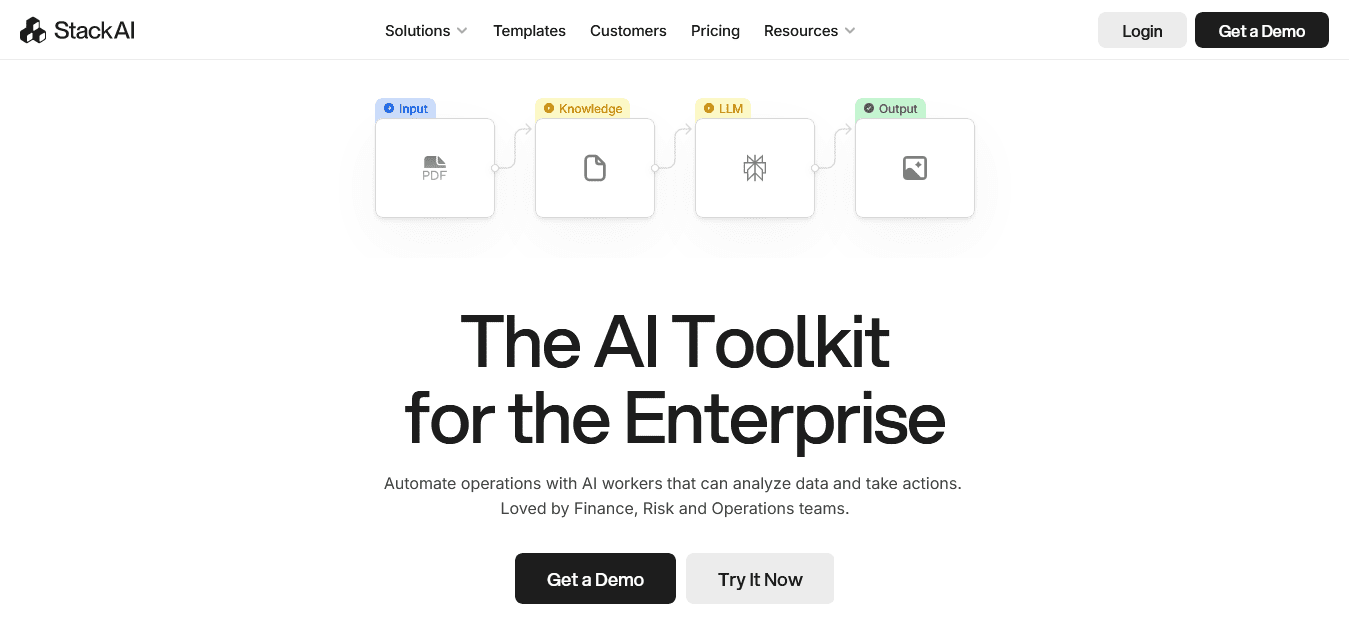
For organizations that want a balance between no-code simplicity and scalable automation, Stack AI is a strong contender. It is designed to help teams design, build, and deploy custom AI assistants and workflow automations without requiring advanced coding or AI knowledge. Its low-code/no-code environment makes it particularly useful for non-technical users who want to integrate AI into their daily operations without heavy reliance on developers.
Stack AI uses a drag-and-drop interface to connect logic nodes, models, and data connectors, making it easy to set up workflows visually. To reduce setup time, the platform also offers pre-built templates for common use cases like chatbots, analytics tools, or customer support automations. It supports multi-model setups, so teams can choose the best AI model for their use case, whether conversational or analytical. For businesses, Stack AI ensures compliance with SOC 2, GDPR, and HIPAA that makes it a reliable option for handling sensitive enterprise data.
Pros
-
Very intuitive for non-technical teams thanks to drag-and-drop design.
-
Excellent customer support with hands-on troubleshooting.
-
Handles multi-model and RAG workflows at scale with strong API support.
-
Offers ready-made templates that save time in setup.
-
Strong security and compliance for enterprise use.
Cons
-
Performance can be inconsistent with occasional delays.
-
Steeper learning curve compared to simple chatbot builders.
-
Pricing is custom and can be unpredictable for budget planning.
How to Create an AI Agent for Non-Technical Teams? [Practical Guide with GPTBots]

While exploring platforms for building AI strategies for non-technical leaders, we tested multiple options and found that GPTBots stands out as the most practical and user-friendly choice. While there are many tools that allow AI automation, GPTBots is designed specifically with non-technical users in mind, making it possible to create and deploy intelligent AI agents without writing a single line of code.
Here’s why GPTBots is the right choice:
- No Technical Skills Required – Anyone, regardless of coding background, can build and launch AI agents.
- Intelligent Capabilities – GPTBots agents are conversational, context-aware, and capable of handling complex workflows.
- Customizable & Flexible – Adjust the agent’s behavior, tone, and role to fit your exact business needs.
- Seamless Integrations – Connect your agent to tools like Slack, WhatsApp, CRMs, and websites with minimal effort.
- Scalable for Growth – Start small and expand as your business needs grow without switching platforms.
- Built-in Analytics – Track performance with dashboards to monitor conversations and improve accuracy over time.
Now let’s walk through a step-by-step practical guide on how non-technical teams can create an AI agent using GPTBots.
Step 1: Create Your First AI Agent
The first step is to log into GPTBots and start a new agent project. GPTBots provides ready-to-use templates for common use cases such as customer support, FAQs, or lead generation. These templates help non-technical users avoid starting from scratch.
If you prefer more control, the drag-and-drop interface allows you to build workflows visually by connecting blocks for logic, responses, and actions. This way, you can decide how the agent greets users, what kind of information it can provide, and how it should escalate complex queries.
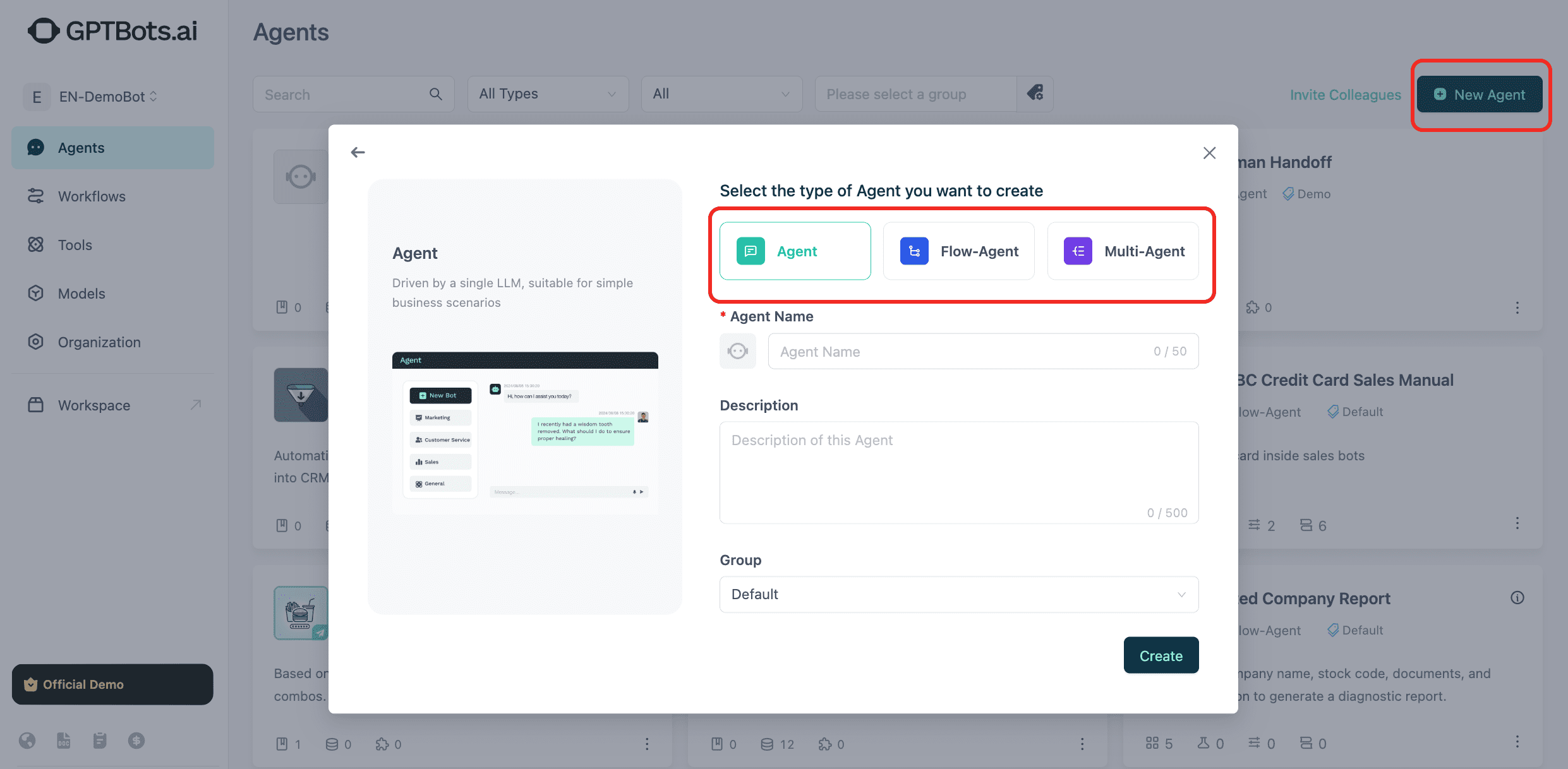
Tip for non-technical leaders: Start with a simple use case (like answering FAQs) before scaling into more advanced workflows.
Step 2: Add Knowledge and Optimize
Once your agent is created, the next step is to make it smarter by giving it access to your company’s knowledge base. GPTBots allows you to upload documents, FAQs, and even connect databases so that the agent can provide accurate, real-world responses instead of generic answers.
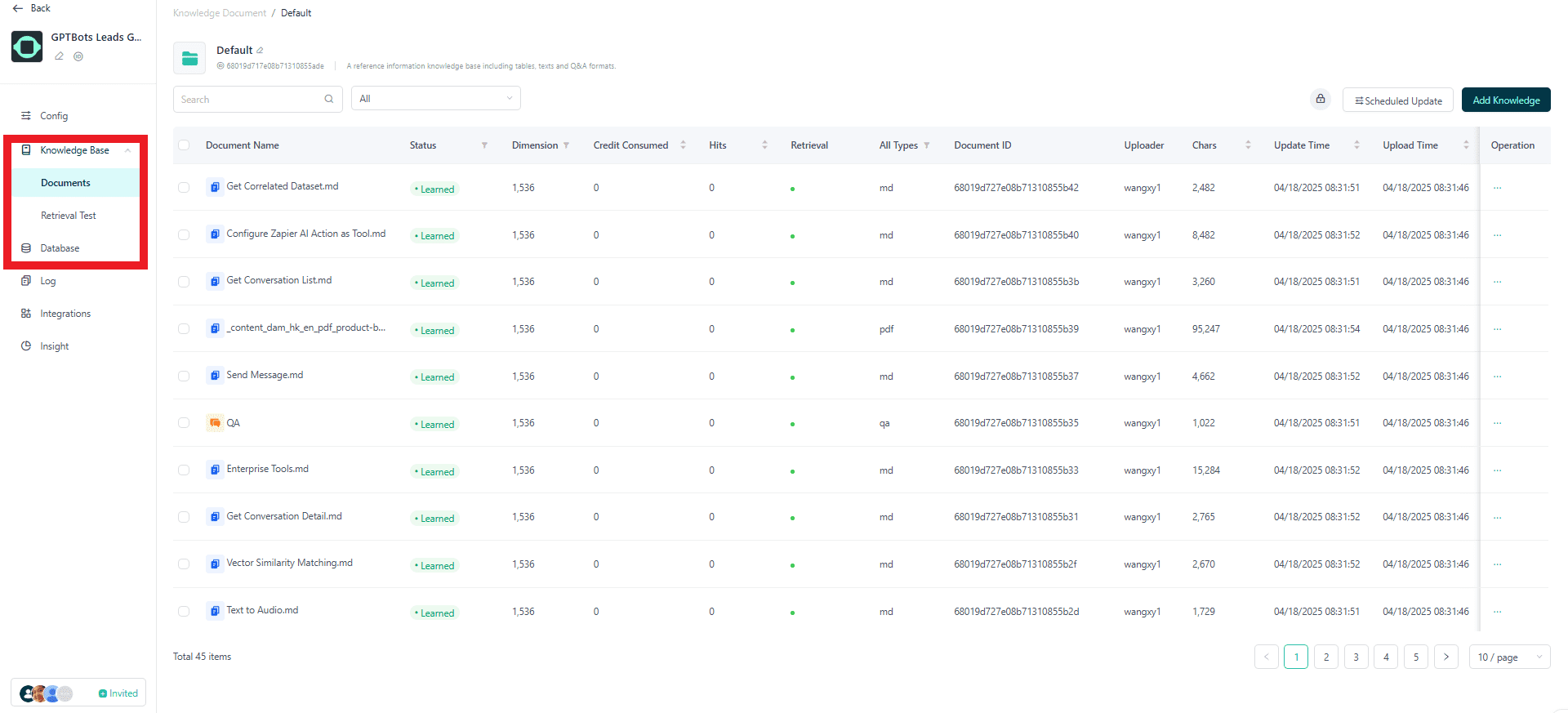
This step is crucial for building AI strategies for non-technical leaders, because it ensures that the agent represents your organization’s voice and knowledge. GPTBots also allows real-time testing of “flows,” so you can chat with your agent while building it, see how it responds, and make immediate improvements.
Step 3: Debug and Fine-Tune
Even the best AI agents need adjustments. GPTBots provides built-in tools to debug and optimize performance by showing you how your agent responds to different queries. You can check for accuracy, tone, and relevance, then make refinements with just a few clicks.
This step ensures that your AI agent feels natural in conversation and is aligned with your business objectives. By testing continuously, you can prevent common pitfalls like irrelevant responses or overly robotic replies.
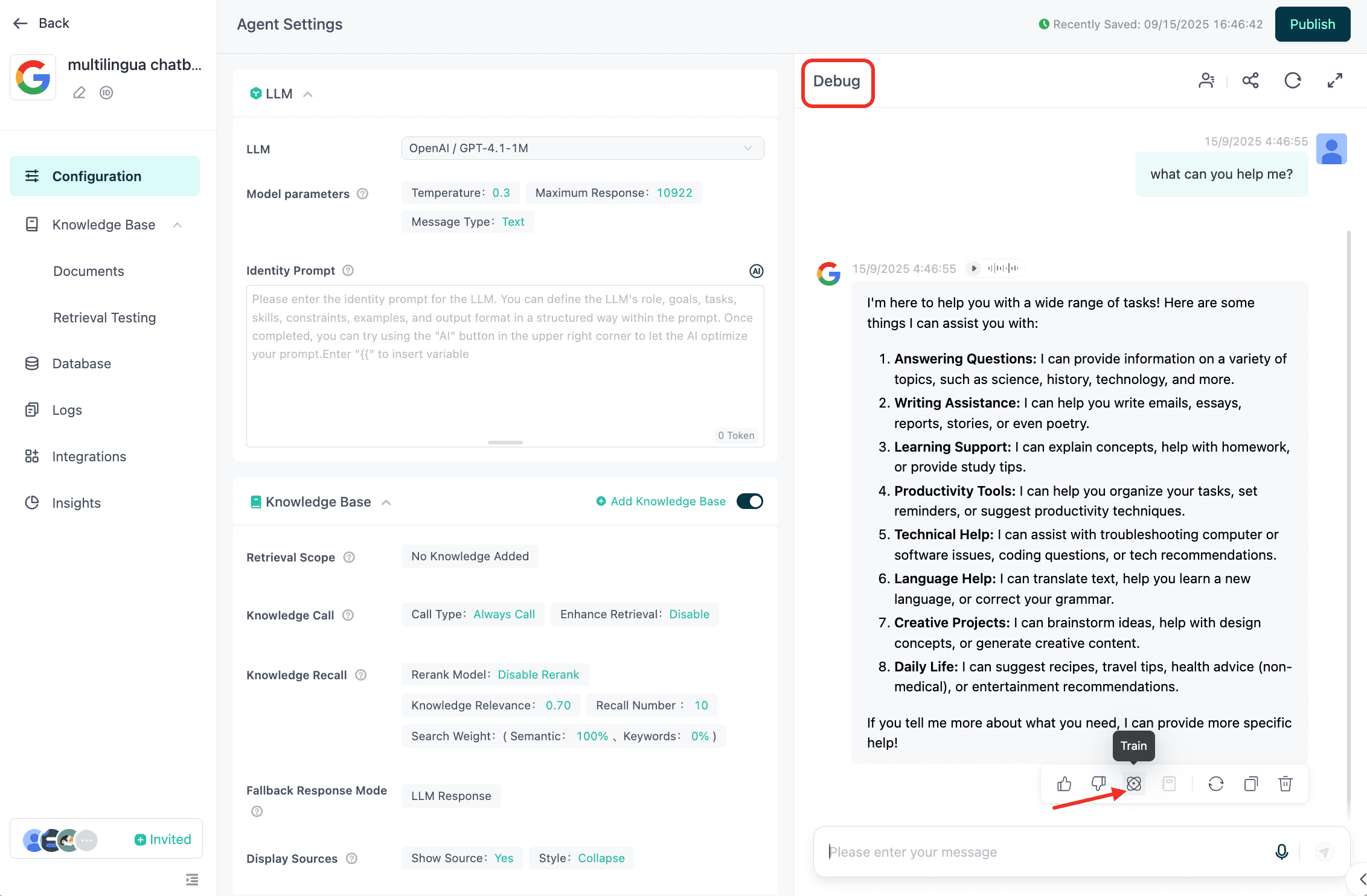
Step 4: Deploy Across Platforms
After testing, you’re ready to bring your agent to life. GPTBots makes deployment simple by supporting multiple platforms at once. You can integrate your AI agent into:
- Company website (through chat widgets or iframes)
- WhatsApp for customer communication
- Slack or Discord for internal team support
- CRMs and custom APIs for business workflows
This multi-channel support means your AI agent isn’t limited to a single tool. Instead, it becomes available everywhere your team or customers interact, increasing its impact and adoption.
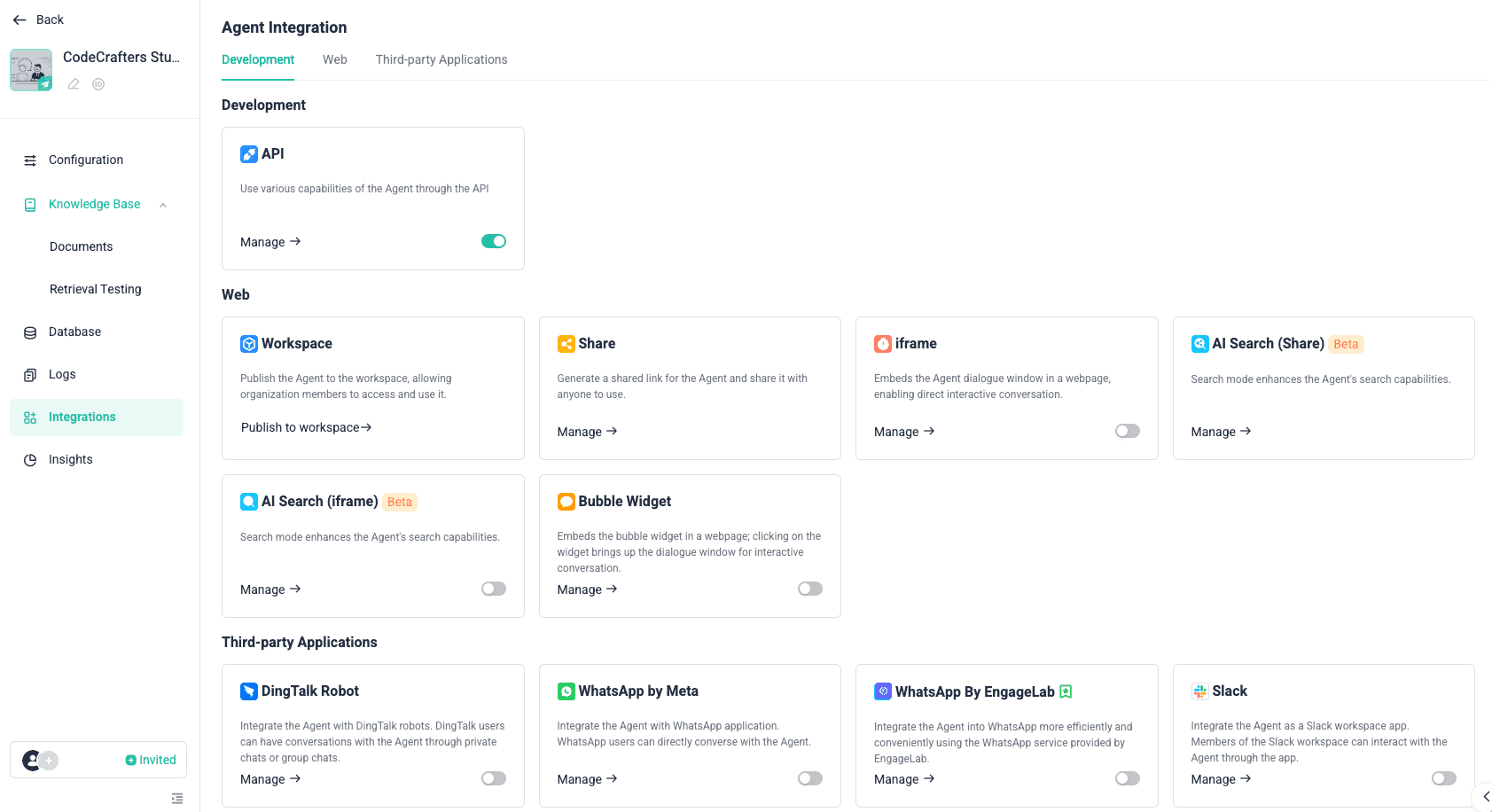
Step 5: Train and Continuously Improve
Launching your AI agent is just the beginning. GPTBots comes with training and analytics tools that help you improve over time. You can see what type of questions your users are asking, how your agent responds, and where adjustments are needed.
By continuously feeding new data, FAQs, or customer insights into the system, your agent becomes smarter and more reliable. Over time, it will be able to handle more complex conversations with minimal supervision.
FAQs About AI Tools for Non-Technical Users
1. What are AI tools for non-technical users (B2B)?
AI tools for non-technical users (B2B) are platforms designed for businesses that don’t have advanced coding or data science teams but still want to benefit from AI. These tools usually come with drag-and-drop interfaces, pre-built templates, and easy integrations, allowing sales, marketing, HR, and customer support teams to create intelligent automation without writing code. For example, a marketing manager can set up an AI chatbot to handle customer queries or analyze campaign performance without needing technical expertise.
2. How can non-technical teams create AI clinicians?
The idea of how non-technical teams create AI clinicians may sound complex, but modern no-code AI platforms are making it possible. Healthcare organizations can use these tools to build AI-powered assistants (often referred to as AI clinicians or virtual health advisors) that help with triaging patient questions, providing preliminary guidance, and managing administrative tasks like appointment scheduling. These tools don’t replace doctors but serve as support systems to reduce workload and improve patient engagement. Non-technical healthcare staff can use intuitive dashboards and preset healthcare templates to deploy AI clinicians safely and effectively.
3. Are AI tools really easy to use without technical expertise?
Yes. Most modern platforms are specifically designed to make AI accessible for everyone. Instead of coding, users can rely on visual workflows, simple rule-based logic, and step-by-step guidance. These platforms often include expert assistance, ready-made industry templates, and real-time testing environments, so users can see results immediately. The whole idea is to make AI adoption as smooth as using any other business software.
4. What types of businesses benefit most from AI tools for non-technical users?
Almost every industry can benefit, but the tools are particularly valuable in:
- Customer Service – Automated chatbots and support agents.
- Sales & Marketing – Lead capture, personalized outreach, and data analysis.
- Healthcare – Virtual assistants, AI clinicians, and patient engagement systems.
- Human Resources – Candidate screening, onboarding, and employee support.
- E-commerce – Personalized shopping experiences and 24/7 support.
These solutions are ideal for small to mid-sized businesses that may not have technical teams but want to leverage AI for growth.
5. Are AI tools for non-technical users secure?
Security is one of the top concerns for businesses, and most AI tools for non-technical users (B2B) are designed with enterprise-grade compliance. Many of them meet standards like SOC 2, GDPR, or HIPAA, depending on the industry. They also provide options for private deployment, meaning sensitive data doesn’t leave your organization’s environment. Before choosing a platform, businesses should always check for compliance and data privacy policies.
6. How much do these tools usually cost?
The cost varies depending on the platform and usage. Many providers offer free tiers with basic features so businesses can test the platform. Paid plans may range from affordable monthly subscriptions for small teams to enterprise-level pricing for larger organizations. While some platforms charge per user or per workflow, others use credit-based systems tied to the number of AI interactions. For B2B companies, the investment often pays off quickly by reducing manual work and improving efficiency.
7. Can AI tools replace employees?
No, AI tools are not meant to replace employees but to augment and support them. For example, an AI clinician can handle preliminary patient questions, but doctors still provide the final medical advice. Similarly, AI in HR can screen resumes, but recruiters still make the final hiring decisions. The real value lies in freeing human employees from repetitive tasks so they can focus on high-value work.
8. How do I choose the best platform for my business?
The right choice depends on your goals, budget, and industry needs. For example, if your team wants to build conversational agents, platforms like Voiceflow or GPTBots may be ideal. If your focus is workflow automation, n8n or Relevance AI might be a better fit. Look for a tool that offers:
- No-code interfaces for easy adoption.
- Templates specific to your industry.
- Integrations with the software you already use.
- Scalability and security features.
This way, even without technical expertise, you can start building effective AI agents aligned with your business strategy.
The Bottom Line
AI is no longer just for data scientists or developers. Today, businesses of all sizes can use AI tools for non-technical users to build intelligent agents that save time, reduce costs, and improve customer experiences. With the right platform, non-technical teams can automate tasks, create smarter workflows, and unlock new opportunities without needing to code.
If you’re ready to see how this works in action, start with a platform built for simplicity and impact.
Contact Sales


